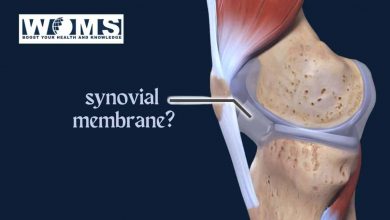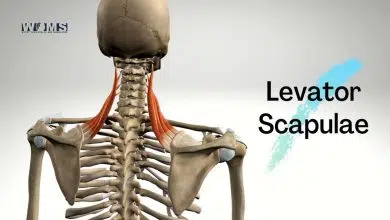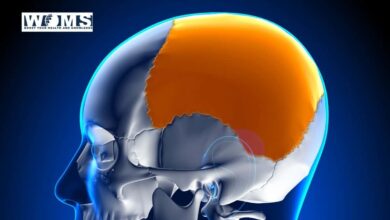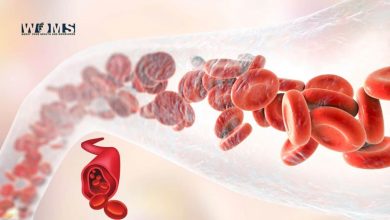Temporal Bone
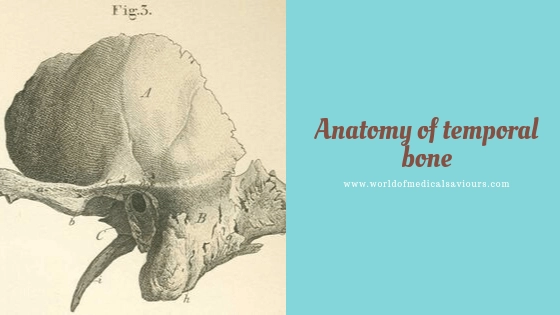
Temporal bones are two in number; situated at the sides and base of the skull: chief bone of the temporal region and each temporal bone contains the organs of hearing and equilibrium. The lower facial nerve and major vessels to and from the brain pivot the temporal bone.
Parts of Temporal bone
Morphologically and developmentally, temporal bones are divided into four parts. The parts of the temporal bone are:
- Squamous: develops as a dermal bone (in the membrane) to protect the brain.
- Petro-mastoid: develops as a cartilaginous capsule (protective capsule) around the membranous labyrinth of the internal ear.
- Tympanic: develops in the membrane as a ring of bone in connection with external meatus to conduct sound waves in the air medium.
- The Styloid process develops as a skeletal derivative of 2nd branchial arch.
Anatomically, for descriptive reasons, the petromastoid part is described as consisting of 2 separate parts—mastoid and petrous.
Hence, the 5 parts of the temporal bone are:
- Squamous
- Mastoid
- Petrous,
- Tympanic and
- Styloid process.
Determination of side:
- The Squamous part is thin and plate-like and forms the anterior and upper parts of the temporal bones; from Its external surface projects zygomatic process, at first horizontally, laterally, and then directed anteriorly.
- The petrous part Is wedge-shaped; the base of the wedge is fused with squamous and mastoid parts and the apex is directed medially, forward, and upward.
1. Squamous part
The Squamous part of the temporal bones is thin, translucent, and expanded plate-like; forms the anterior and upper part of the bone.
Presents:
- 2 Surfaces: External (temporal) and Internal (cerebral).
- 2 Borders: Superior and Antero-inferior.
- 1 Process: Zygomatic process arises from the lower part of the external surface.
1 Fossa: Mandibular fossa of the temporal bone is partly constituted by the external surface of the squamous part and partly by the tympanic part.
- Surfaces
- External (Temporal) surface: smooth and slightly convex and forms most of the medial wall of the temporal fossa.
Presents:
- Origin of Temporalis muscle: from the whole external surface excepting the zygomatic process and mandibular fossa.
Presents:
- Groove for middle temporal vessels above the opening of the external auditory (acoustic) meatus.
- Supramastoid crest: a curved ridge or line running upwards and backward from above the anterior part of external auditory meatus; gives attachment to the temporal fascia forms the posterior limit of the temporal fossa.
- Squamous-mastoid suture: lies about 1.25 cm. below and behind the supramastoid crest; indicates the line of fusion of squamous and mastoid parts.
- Origin of Auricularis posterior muscle: from the middle of the space between supramastoid crest and squamous-mastoid suture.
- Supramental triangle: a small triangular depression between the anterior end of the supramastoid crest, and posterosuperior sector of the external auditory meatus and a tangent line drawn along the posterior border of the external auditory meatus.
Importance: It is an important bony landmark for the mastoid antrum which in the adult lies 1.25 cm deep to it.
- Supramental spine: a small bony projection at the anterior part of the supramental triangle.
- Zygomatic process: a long arched process projecting horizontally, laterally, and then directed anteriorly from the lower and anterior part of the temporal surface; articulates in front with the temporal process of zygomatic bone to exhaustive the zygomatic arch.
Process 2 parts:
- Anterior and
- Posterior
a) ANTERIOR PART: thin and flat;
The anterior part presents:
- 2 surfaces: internal: convex and subcutaneous.
Medial: concave and gives origin to Massater muscle from its lower part.
- 2 borders: upper: gives attachment to the temporal fascia
lower: arched gives origin to Masseter muscle.
- 2 ends: anterior: serrated; articulates with the temporal process of zygomatic
Posterior: continuous with the posterior part of the zygomatic process.
b) POSTERIOR PART: blubbery and triangular.
Presents:
- 3 borders: base: it is united with the squamous part.
anterior: constitutes the anterior root of (medial border) the process.
Posterior: constitutes the posterior root of the process.
The two roots meet laterally into a tubercle known as the tubercle of the root of zygoma which gives attachment to the lateral ligament of the temporomandibular joint of the temporal bones.
At the tubercle, the zygomatic process is twisted into a thin anterior part. The posterior root is continuous behind with supramastoid crest and in front with an upper border or anterior part of the zygomatic process.
- Two Surfaces : superior: concave and continuous with the temporal surface.
inferior: convex and mostly occupied by the inferior surface of the anterior root which composes a stiffened bar of bone in front of the mandibular fossa. The condensed bar of bone is known as an articular tubercle. This articulates with the articular disc of the temporomandibular joint.
- A small triangular area in front of the articular tubercle forms the root of the infra-temporal fossa; it is limited by a ridge continuous behind with the anterior root of the zygoma and in front with the infratemporal crest of the greater wing of the sphenoid bone.
- Squamosal foramen: very rarely present just above the anterior root of the zygomatic process; when present.
Transmit Petro-squamous sinus.
- Mandibular fossa: formed by the squamous part and partly by the tympanic part of the temporal bones.
Possesses 2 parts :
- ANTERIOR (articular): formed by squamous part: smooth, oval, and deeply concave; bounded in front by the convex articular tubercle; articulates with the articular disc of the temporomandibular joint.
- POSTERIOR (non-articular): formed by the tympanic part; contains a portion of the parotid salivary gland.
Present :
- Post-glenoid tubercle: a small conical eminence separating laterally the articular(squamous) part of mandibular fossa from the non-articular (tympanic) part; sometimes called the 3rd root of the zygomatic process.
- Squamous-tympanic fissure: lies medially between the articular part of the mandibular fossa and tympanic part of the temporal bones; divided by the projection into it of the lower edge of the downturned anterolateral portion of tegmen tympani of the petrous part of temporal bones into 2 parts.
- Petro tympanic fissure: between tegmen tympani and tympanic part: important fissure because it communicates with the tympanic cavity (middle ear): lodges the anterior ligamént of the malleus.
Transmits :
- anterior tympanic branch of maxillary outer to the middle ear and
- at its medial end, there is the opening of the anterior canaliculus for the chorda tympani nerve for its exit from the middle ear.
a) Petro-squamous fissure: between tegmen tympani and squamous part; transmits no structure.
- Internal (cerebral) surface: concave.
Presents:
- Impressions corresponding to convolutions of the temporal lobe of the cerebral hemisphere which lies to it but separated from it by meninges.
- Grooves: for middle meningeal vessels.
- Petro-squamosal suture: may be present interiorly where the cerebral surface of the squamous part unites with the petrous part.
- Petro-squamosal sulcus: may be present close to the site of the union of the cerebral surface of the squamous part with the petrous part: when present, it lodges the Petro-squamosal sinus.
(ii) Borders - Superior border: articulates with the inferior border of parietal bone and forms the squamosal suture.
- Antero-inferior border: articulates with the greater wing of the sphenoid temporal bone.
2. Mastoid part
Mastoid part of temporal bones forms the posterior (posteroinferior) part of the temporal bones and is thicker than the squamous part
Presents:
- 2 Surfaces: External (lateral) and Internal (medial or cerebral).
- 2 Borders: Superior and Posterior.
- 1 Process: Mastoid process projecting from the anteroinferior part of the external surface.
(i) Surfaces
- External surface: convex and rough.
The external surface of mastoid parts Presents:
- Attachment of following muscles in order from above downwards and forwards.
- Origin of Auricularis posterior: close to the middle of a squamous-mastoid suture.
- Origin of Occipital belly of Occipito-frontalis.
- Insertion of Sternocleidomastoid {attachment extending on to the surface of the mastoid process.}
- Insertion of Splenius capitis
- Insertion of Longissimus capitis
- Mastoid process: The mastoid process of temporal bones are a conical projection from the anteroinferior part of the external surface larger in male than in the female.
Presents:
- External surface: continuous with the external surface of the main part; gives insertion to Sternocleidomastoid, Splenius capitis, Longissimus capitis muscles as mentioned above.
- Mastoid notch: a broad notch that belongs to the medial aspect of the process; the notch and the part below it give agent to the Posterior belly of the digastrics muscle.
- Occipital groove: a shallow groove below the notch: lodges occipital artery.
- Mastoid foramen: position is variable; usually lies close to the posterior border;
Transmits:
- an emissary vein from the sigmoid sinus to posterior auricular vein (exit).
- a small branch of the occipital artery (entrance).
- Internal surface: concave and forms part of the posterior cranial fossa.
Sigmoid sulcus: a deep curved groove which lodges sigmoid sinus; in its floor opens the mastoid foramen.
Borders
- Superior border: short, thick, and serrated; forms a notch with superior border of the squamous part; articulates with posteroinferior part (forming mastoid angle) of parietal
- Posterior border: thick and serrated; articulates with inferior (Mastoid) border of the squamous part of the temporal bones.
Mastoid air cells
Several irregular air spaces are present in the mastoid part of the temporal bones which can be seen in a section; one large air space is known as Mastoid or Tympanic antrum; mastoid air cells are intercommunicating and they also communicate with middle car cavity (Tympanic cavity).
3. Petrous part
The petrous part of the temporal bones lies between the sphenoid and occipital bones at the base of the articulated skull; contains the organs of hearing and equilibration; very hard (GK, petrous ivory, or stony hard); wedge-shaped.
Parts:
Base: fused with the squamous and mastoid parts.
Apex: directed medially, forwards and upwards; lies in the angular interval between the posterior border of the greater wing of sphenoid and basilar part of occipital; pierced by the anterior orifice of the carotid canal; forms the postero-lateral boundary of foramen lacerum.
3 Surfaces: Anterior, Posterior, and Inferior.
3 Borders: Anterior, Superior, and Posterior.
(i) Surfaces
- Anterior surface: continuous with the cerebral surface of the squamous part; forms the floor of the middle cranial fossa in the articulated skull.
Presents:
- Impressions for sulci and gyri of the temporal lobe of the cerebral hemisphere.
- Trigeminal impression: a depressed area just behind the apex; lodges the Trigeminal (semilunar) ganglion.
- The second hollow behind the trigeminal impression but separated from it by an irregular ridge; forms parts of the roof of the internal auditory meatus and covers the cochlea
- Arcuate eminence: an elevation behind the second hollow: it is caused by the superior semicircular canal of the internal ear; its lateral part overlies the vestibule and the facial canal; its posterior sloping part overlies the posterior and lateral semicircular canals of Internal ear.
- Tegmen tympani: a thin plate of the temporal bones lying between the squamous part laterally and arcuate eminence and the two hollows medially; forms the roof of the mastoid (tympanic) antrum, the tympanic cavity (middle ear), and the canal for tensor tympani; its lateral part meets the squamous part of the Petro-squamosal suture and turns down in front (downturned anterolateral part ) to form the lateral wall of the canal for tensor tympani and the bony part of the auditory (pharyngo-tympanic or eustachian or acoustic) tube; this down-turned anterolateral part of tegmen tympani projects into the squamous-tympanic fissure and divides it into petro-tympanic and Petro-squamous fissures; it also
Presents:
- Hiatus for greater petrosal nerve: a faint groove on the anterior part of tegmen tympani containing the nerve; leads posteriorly into a very tiny foramen which transmits the nerve; the greater petrosal nerve forward to the foramen lacerum.
- Hiatus for lesser petrosal nerve: another faint groove containing lesser petrosal nerve lies lateral to the above hiatus.
- Posterior surface: continuous with the cerebral surface of the mastoid part; forms the anterior part of posterior cranial fossa in the articulated skull.
Presents:
- orifice of Internal auditory (acoustic) meatus: a circular aperture near the center of this surface; gives
- entrance to the motor root of the facial nerve.
- entrance to the labyrinthine (internal auditory) artery.
- entrance to the motor root of the facial nerve.
- exit to vestibule-cochlear (state acoustic or auditory) nerve.
- exit to the labyrinthine vein.
2. Opening of Aqueduct of Vestibule: a small slit under cover of a thin plate of bone behind the opening of the vestibule which contains-the saccus and ducts endolymphatic along with a small artery and vein.
3. Subarcuate fossa: an irregular depression above and between the two openings just described above, lodges a process of dura mater and transmits a vein.
4. Inferior surface: rough and irregular, forms part of the inferior surface of the base of the skull.
Presents:
a) A quadrilateral rough area near the apex-gives:
- Origin to Levator Veli Palatini muscle
- Attachment to the cartilaginous part of the auditory tube; it’s lower part articulates with the basilar part of occipital bone by dense
fibrous tissue.
b) The external or lower opening of the carotid canal: a nearly circular opening behind the rough quadrilateral area.
Transmits: Internal carotid artery with the plexus of sympathetic nerves and Internal carotid plexus of veins.
c) Jaguar fossa: a deep depression behind the opening of the carotid canal; lodges the superior bulb of internal jugular vein
d) A triangular depression lies in front of the medial part of the opening of the carotid canal and below the internal auditory meatus; lodge the inferior ganglion of the glossopharyngeal nerve.
e) Opening of cochlear canaliculus: present at the apex the triangular depression; this leads to the cochlear canaliculus which lodges
-
- the aqueduct of the cochlea and
- prolongation of dura mater and transmits-
a small vein from the cochlea into an internal jugular vein; through the aqueduct of the cochlea, the perilymph of the labyrinth is drained into subarachnoid space.
f) Opening of tympanic canaliculus: lies on the bony ridge separating the opening of the carotid canal from the Jugular fossa;
Transmits the Tympanic branch of the glossopharyngeal (IXth cranial) nerve.
g) Opening of mastoid canaliculus: present on the lateral part of Jugular fossa
Transmits Auricular branch of vagus (Xth cranial) nerve.
h) Jugular surface: a small quadrilateral articular surface behind the jugular fossa; articulates with the jugular process of the occipital part of the temporal bones.
(ii) Borders
- Superior border: longest and grooved; the groove lodges superior petrosal sinus: margins of the groove give attachment to tentorium cerebelli except at its medial end.
- Posterior border: smaller than the superior but bigger than the anterior; divided into 2 parts
- Medial and
- Lateral.
Medial part: articulates with the lateral border of the basilar part of the occipital bone and forms a groove (sulcus) to lodge the inferior petrosal sinus.
Lateral part: with the jugular notch of the condylar part of the occipital bone it forms the jugular foramen which
Transmits Glossopharyngeal (IX), Vagus (X), and Accessory (IX) cranial nerves and inferior petrosal sinus (which opens into an internal jugular vein) and sigmoid sinus.
- The anterior border is divided into two parts.
- Lateral: joined with the squamous part at the petro-squamosal suture
- Medial: articulates with the greater wing of the sphenoid bone.
Canals for Tensor Tympani muscle and Auditory tube
Two canals are placed one above the other but separated by a thin plate of bone at the site of union of the petrous and squamous parts of temporal bone; both canals lead into the tympanic cavity (middle ear); the upper canal gives passage to the tensor tympani muscle and the lower forms the canal of the auditory tube.
4. Tympanic part
The tympanic part of the temporal bones forms a plate of the bone in the adult; lies between the squamous and mastoid parts.
In front, it joins with the squamous part to form the squamous tympanic fissure of the temporal bones.
Behind, it joins with the mastoid part to form the tympano-mastoid fissure through which the auricular branch of vagus nerve comes out.
Medially, it is fused with the petrous part.
Processes: 2 Surfaces: Anterior and Posterior
3 Borders: Lateral, Upper and Lower portions of the temporal bones
-
Surfaces
- Anterior surface: gently concave and roughly quadrilateral, terms the posterior non-articular part of the mandibular fossa and is related to a portion of the parotid salivary gland.
- Posterior surface: forms the anterior wall, floor, and lower part of the posterior wall of the bony part of the external auditory meatus.
Presents :
Tympanic sulcus: a circular sulcus (deficient above) at the medical end of this surface, gives attachment to the margin of the tympanic membrane.
-
Borders
- Lateral border: forms greater part of the circumference of the lateral end of the bony part of the external auditory meatus; gives the adapter to the cartilaginous part of the external auditory meatus.
- Upper border: its lateral part is fused with post-glenoid tubercle, its medial part forms the posterior boundary of Petro- tympanic fissure.
- Lower border: extends from the opening of the carotid canal to the styloid process. It is sharp and gives attachment to the cervical fascia.
Presents:
The sheath of the styloid process: the lateral part of the lower border splits to enclose the root of the styloid process and is called the sheath of the styloid process.
External auditory meatus
It is one of the 2 parts of the external ear, the other part being auricle, it is a passage for the conduction of sound waves in air medium, 24 mm in length, made up of cartilage and the temporal bones, the ratio is 1: 2 (cartilaginous part -8 mm, bony part 16 mm).
The bony part is formed by squamous and tympanic parts of temporal: the squamous part forms only the roof and upper part of the posterior wall while the tympanic part forms the anterior wall, floor and lower part of the posterior wall; it is directed medially, forwards and downwards; the lateral end is open and is connected with the cartilaginous part while the medial end presents the tympanic sulcus to which the tympanic membrane is attached and is thus closed.
The tympanic membrane forms a partition between the external ear and the middle ear.
The floor and anterior wall of the meatus are boundless than the roof and posterior wall, so the tympanic membrane is obliquely allocated.
5. Styloid process
The styloid process of temporal bones is a slender process, thin and pointed, projecting downwards and forwards from the undersurface of the petrous part of the temporal bones; about 2.5 cm long derivative of the skeletal element of 2nd branchial arch.
ATTACHMENTS:
a) Muscles: Origin of
-
- Styloglossus: from its anterior aspect near the tip.
- Stylohyoid: from the middle of its posterior aspect.
- Stylopharyngeus: from its medial aspect close to the
b) Ligaments:
-
- Stylohyoid ligament: attached to the tip; this ligament represents the fibrous remains of the skeleelementsment of the 2nd branchial arch.
- Stylomandibular ligament: attached to its lateral aspect; this ligament is a condensation in the deep lamina of parotid fascia (part of cervical fascia).
Besides the muscles and ligaments of temporal bones which are attached to it. It has several important relations.
- Anteriorly: To the tympanic part which splits to form the sheath of the styloid process.
- Laterally: Crossed by the facial nerve at its base and external carotid artery at its tip: covered by the parotid salivary gland in its upper part of the temporal bones.
- Posteriorly: There is a foramen, the stylomastoid foramen which lies between styloid and mastoid processes: it is the lower end of the facial canal and gives
- exit to Facial nerve
- entrance to the Stylomastoid branch of the posterior auricular artery.
- Medially related to the carotid sheath.
This concludes the topic of Temporal Bones. We hope you find this post helpful.
